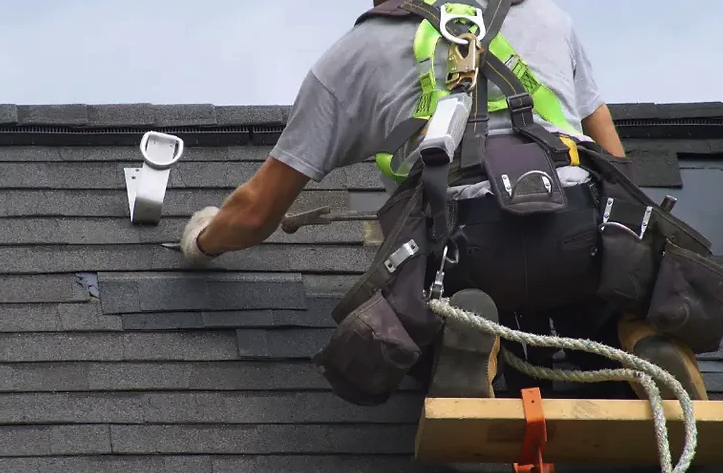10 Most Important Things to Know About Replacing Your Roof
By Shantell Moya · 7 months ago · 13 min read

When your roof starts to show signs of wear and tear, you might want to think about getting it replaced. Your roof keeps you safe from the rain, sun and snow and helps keep your home warm in the winter and cool in the summer.
But roofs don’t last forever. At some point, you’ll need to put on a new one.
Getting a pro to replace your roof makes a lot of sense. You won’t have to worry about fixing any leaks or other issues down the road and a new roof can even make your house worth more money if you ever want to sell it.
I’m going to tell you how to spot when your roof is on its last legs. We’ll talk about what it might cost to replace it and I’ll help you figure out if you should try to do the job yourself or call in the experts. Let’s take a look at what goes into getting a new roof for your home!
1. Recognizing the Signs Your Roof Needs Replacement
The first thing you need to know about replacing your roof is how to spot when it’s time. You might not notice all of the signs of roof damage right away because some aren’t easy to spot. You’ll want to keep an eye out for things like missing shingles or shingles that look beat up and worn. Water stains on your ceiling or walls inside your home are another major clue that something’s wrong. If you can see daylight coming through your roof boards from inside, that’s definitely not ideal.
When you spot these problems, you probably shouldn’t wait too long to get a new roof. Putting it off typically leads to bigger headaches later on down the road. Water that keeps getting in can damage the wooden structure of your house.
Those spots where light comes through mean your home isn’t well insulated in those areas, so you’re likely paying more for your heating and cooling bills than necessary. Taking a careful look at your roof every so often and getting it checked by someone who knows what they’re doing, will help you catch these issues before they become serious problems.
2. Understanding Roofing Material Lifespans
Your roof’s materials last for different amounts of time and knowing this timeline can help you plan ahead for when you’ll need to get a new one. Take asphalt shingles as an example and many homeowners pick them because they typically last somewhere between 15 and 30 years.
If you choose a metal roof, you might not need to replace it for 50 years or more – the downside is that it costs more money upfront. Materials like tile or slate can last even longer. But you’ll need to take care of them more regularly and installing them on your house can be pretty expensive at the start.
When it comes down to it, you might want to choose the roofing material that fits your budget and works well with your local weather conditions while also just looking right to you. Looking at how long each type lasts can give you some the details you need to make a smart and thoughtful choice when your old roof needs to go!
3. The Impact of Climate on Your Roofing Decision
Your climate plays a big role in the kind of roof you should choose. You’ll find that some materials simply work better depending on the kind of weather you get in your area.
Take metal roofs as an example. If you live somewhere that gets a lot of snow in the winter, metal might be a solid choice because the snow slides right off instead of piling up, which helps keep your roof from getting damaged under all that weight.
In hot places, clay tiles are really practical. They don’t soak up the heat like other materials do, so your house stays cooler even when the sun is beating down all day long. You should take a thorough and complete look at what kind of weather happens in your area throughout the year before you make your final decision. When you pick the right material for your climate, your roof will last longer and your home will stay more comfortable too!
4. DIY Roof Replacement vs Professional Services
The choice between putting on a new roof yourself or hiring someone to do it for you isn’t simple. Each option has its good and bad sides to consider.
When you replace your roof yourself, you’ll save quite a bit of money since you won’t be paying for someone else’s time and work. You can take as long as you need to finish the job. But doing your own roof isn’t something that just anyone should try since roofing is hard work that requires skills and know-how most people don’t have.
When you hire roofing experts, you benefit from their knowledge and generally better results. They know how to handle surprise problems that might pop up during the job and can guide you through the whole process. The downside is that you’ll pay more money for their help.
Putting on a roof can be really dangerous and professionals have safety gear and training to help avoid getting hurt. They also do better work because they know which methods and products will last the longest.
If you replace your roof yourself, it’ll probably take you much longer to finish because professionals can get it done faster by doing this kind of work every day. When you hire pros, they usually promise that their work will last for a set amount of time. In the end, what’s right for you depends on how much money you want to spend, what abilities you have and how confident you feel about doing big home improvement projects.
5. Calculating the Cost of Roof Replacement
The cost to replace your roof isn’t going to be the same for everyone. You’ll find that the prices can change based on a few key things about your home and where you live.
First the size of your roof makes a significant difference in what you’ll pay. Larger roofs need more materials and the workers spend more time putting everything in place. This means you’ll end up paying more compared to someone with a smaller roof.
What your new roof is made of matters too. Some materials cost more right from the start. You might choose asphalt shingles, which tend to be less expensive or you might want something like metal or slate that costs more money upfront.
Your roof’s design also affects the final price. If you have a simple roof, it’s going to be faster and easier for the workers to replace. But if your roof has lots of slopes, valleys or things sticking out like chimneys or skylights, the job becomes more complicated. Workers will need to take extra time to work around these areas and that means the labor costs will increase.
Where you live also affects your roof replacement cost. In some areas, workers charge more for their time and the materials might cost more if they have to be shipped from far away.
You might find it tempting to go with the cheapest option you can find. But that’s not always the wisest approach. Less expensive materials might not last as long, which means you could end up paying more down the road when you need to replace your roof sooner than expected. It’s worthwhile to consider how long different materials will last and how well they hold up in your local weather conditions.
6. Choosing the Right Roofing Material for Your Home
Picking the right roofing material makes a big difference for your home. The material that you choose will change how long your roof lasts, how your house looks and even how much you spend on heating and cooling.
You have several solid options to think about for your roof. Asphalt shingles are what most people go with. Metal roofing has become more common these days. Tile roofs give homes a unique look that many homeowners appreciate.
Asphalt shingles don’t cost as much as other choices, which is why so many people like them. You can find them in lots of different colors to match your home. They work pretty well. But they might not hold up as long as some other materials would.
Metal roofs really stand the test of time and help keep your energy bills lower. You’ll pay more money up front for a metal roof. But it might save you cash down the road since you won’t need to replace it as quickly.
Tile roofs catch people’s eye and can last for a very long time. Just remember that tiles weigh quite a bit, so your house needs to be strong enough to hold them up.
Take some time to look at your home’s design, your budget and the weather where you live before making your final choice. This is a decision that you’ll live with for many years, so it’s worthwhile giving it some real thought!
7. The Roof Replacement Process: What to Expect
The roof replacement process might seem a little scary at first. But these steps will help you feel less worried about what’s going to happen.
The team starts by taking off all of your old roofing material. This lets them see your roof deck clearly so they can check it for any problems and if they find spots that need fixing, they’ll repair them right away before moving forward.
After the repairs, our roofers will put down a layer of underlayment. This can give you somer roof extra protection from the elements and then they’ll start laying down your new shingles or tiles in the pattern that you picked out.
Our roofers will also install flashing around areas like chimneys and vents. This metal material helps keep water from sneaking into those tricky spots and causing leaks later on and once everything is properly installed, they’ll clean up all of the old materials and haul them away.
The time needed for all of this really depends on how big your roof is and what kind of materials you’ve chosen. But don’t worry too much about the timeline – a solid and professional team can usually finish the whole job in just a few days!
8. Preparing for Roof Replacement: Homeowner Checklist
Before your roof gets replaced, you can do a few things to make sure that the process goes more smoothly. Taking these extra steps will help you avoid any surprise problems that might pop up.
First you should clear the space around your house. Move your cars, patio furniture and barbecue grills away from the work area so they don’t get damaged by bits of roofing that fall down during the job.
You may also want to think about your plans for being at home. Roof replacement is really noisy, so you might want to find somewhere else to be during the working hours if the noise bothers you too much.
Don’t forget about your stuff inside the house either. All that hammering and walking around on your roof can shake things up. Sometimes pictures or decorations might fall off your walls or shelves, so it’s a smart idea to take them down or put them somewhere safe until the work is done.
Make sure to let your neighbors know about the upcoming work too, as they’ll probably appreciate the heads-up about the noise and activity. If you have pets, you should have a plan for them as well because many animals get scared or upset by loud construction noises. You might need to keep them in a quiet room or take them somewhere else for the day.
9. Navigating Roofing Warranties and Insurance Claims
Roof warranties really do matter when you’re getting a new roof. The different materials and contractors will give you different kinds of warranties, so it’s helpful to know what you’re getting.
A lot of warranties will take care of any problems with the materials themselves and some will help you out if something goes wrong with how the roof was put on.
You should take some time to look through your warranty and ask your contractor to clear up anything that doesn’t make sense. If you’re replacing your roof because something damaged it, you might need to talk to your insurance company.
Dealing with insurance claims can be a bit of a headache. You’ll want to make sure you take pictures of all of the damage and keep any receipts from fixing things up.
Your insurance probably won’t cover every kind of damage that happens to your roof, so it’s worthwhile to look at your policy or call your agent to find out what they’ll pay for. They can also walk you through how to make a claim and getting a handle on warranties and insurance details might seem like a pain now. But knowing how they work can save you a bunch of time and money down the road!
10. Maintaining Your New Roof for Longevity
After your new roof is installed, you’ll need to take care of it to make sure that it lasts for as long as possible. Checking your roof regularly will help you catch small problems before they turn into big headaches.
It’s a smart idea to check your roof after any bad weather comes through. Strong winds and heavy rain or snow can sometimes damage parts of your roof without you noticing right away.
Finding damage early saves you money in the long run since small fixes are much cheaper than major repairs. Taking care of your roof also means keeping it clean and clear of stuff that doesn’t belong up there.
You should remove any leaves, sticks and other junk that builds up over time. Make sure that your gutters and downspouts aren’t clogged so water can flow away from your house properly. It is also helpful to cut back any tree branches that hang over your roof so they don’t fall and cause damage.
Take a look at your roof for any signs of problems, especially after storms or heavy weather. You’ll want to check that your attic has proper airflow to keep heat and moisture from building up under your roof. Remember that if you take good care of your roof, it can protect your home for many years and even make your house more valuable.
At Roof Republic, we know how much quality roofing matters for your home. If you need to fix or replace your roof, our family business promises quality work and materials for your home.
When we work on your home’s roof, we always put your safety first and try to do better work than you expect. You deserve a team that you can count on for your roofing needs. Get in touch with us for a free consultation about what we can do to make your home safer and more valuable. We also have payment plans available to help you afford your roofing project.




Comments
Sort by: